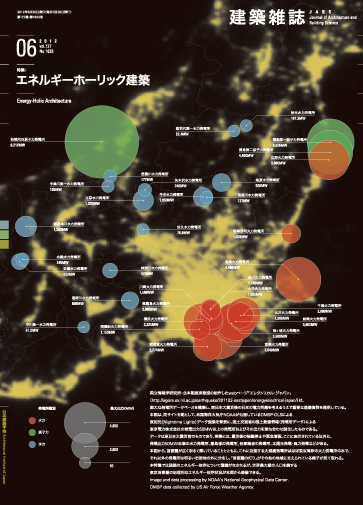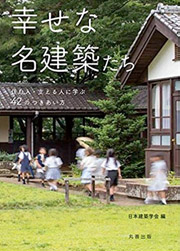本文PDFの閲覧につきましては、こちらでご確認ください。

2012-6月号 JUNE
特集= エネルギーホーリック建築
Energy-holic Architecture
特集前言 建築とエネルギーの3. 11
オイルショック以降、わが国では設備システムの高効率化、空調負荷軽減のための建物の性能強化、原子力を含む代替エネルギー資源の開発などが精力的に進められた。同時に、エネルギーをめぐる問題が、技術だけでなく政治・経済・文化等に深くかかわるきわめて複雑なものであることも、(当然ながら)当時すでによく認識されていた1。
1990年代には地球環境問題が切実化し、たとえエネルギーの枯渇が喫緊でなくともエネルギー消費がもたらす地球環境負荷こそが切迫した問題とされるようになった。これに伴い、一方では建物の建設開始から廃棄処理までに投入されるエネルギーや排出されるCO2の総量が問われ、他方では建築内部環境から地区、都市、地球にいたる環境のダイナミックな階層構造が問われるというように、議論の枠組みは時間的にも空間的にも拡張されてきた。グローバルな新自由主義的経済、第三世界の急成長、先進国の経済混迷や人口縮小といった背景もある。そうしたホーリスティックな視野において持続可能な社会の構築が問われている。
日本建築学会としても、この間一貫した研究や提言などの取組みがあり、「気候温暖化への建築分野での対応(会長声明)」(1997)や、建築関係5団体による「地球環境・建築憲章」(2000)を採択するなど社会的にも発信してきた。
しかしながら、エネルギーの大量消費を前提とする建物が増えていることは事実であり、大都市では環境悪化と負荷増大の負のスパイラルがある。また、オイルショック以降、産業部門のエネルギー消費は増えていない一方で、民生部門(オフィス、住宅など)は2.3倍に膨らんだ。
以上の事情と、制度環境の推移、建築分野の取組みなどについては関連する本誌バックナンバー2 を是非読み返していただきたい。
さて、東日本大震災は、こうした状況に対してどのようなインパクトをもたらすのか。本特集では、「エネルギーホーリック建築」といういささか論争的なタイトルを掲げているが、意図したのは、エネルギーの供給側と、需要側の一員であるデベロッパーや建築界が「3.11」の投げかけるエネルギー問題の様相をどう受け止めたか、現代建築のエネルギー依存体質はあらためてどう浮き彫りになったのか、また、「3.11」は何を加速させ、何を変える契機となったのかを問うことである。
第1部「エネルギー 解体新書」では、これまで本誌ではあまり取り上げられることのなかった電力・石油・ガスの供給体制に目を向け、社会インフラとしての各エネルギーの特質、それぞれの震災時の状況と対応、今夏の電力需給問題、「3.11」以降のパラダイムなどについて検討し、また世界のエネルギー情勢と日本の位置を確認した。冒頭の座談会や記事では電力・石油・ガスの供給側から責任ある立場の方に参加・執筆いただくことができた。
第2部「建築はいかにエネルギー中毒に陥ったのか」では、いわゆる民生部門を構成するオフィスビルと住宅に主に注目しながら、建築供給のエネルギー依存的な体質の現状と、震災時の対応、今後の課題や見通しを探る。また、ゼロ・エネルギー都市としての江戸、再生エネルギー利用をめぐる課題、被災地における仮設住宅の温熱環境に関する取組みや、自然エネルギーによる被災地支援についても寄稿をいただいた。
総じて印象的なのは、第1部でも第2部でも、オイルショック、京都議定書のいずれにも増して、「3.11」のインパクトをはるかに大きく見積もる専門家や業界関係者が多いことである。省エネルギーの技術的蓄積に加え大規模災害リスクの制御という問題が浮上したことや、電力市場化に向かう動きが注目される。福島原発事故は今日のエネルギー問題の焦点だが、原発再稼働が国民的議論になっていないことは気がかりである。エネルギーの供給・利用に関する情報・知識の公開と、事業者・専門家・市民のコミュニケーションの変革が必須であろう。
1:本誌1978年2月号特集「建築における省エネルギー」
2:本誌1999年10月号特集「温暖化のリアリティ」、
2002年4月号特集「気候変動と建築:京都議定書は建築をどう変えるか」、
2004年3月号特集「新・省エネルギー建築」ほか
会誌編集委員会
本号編集担当:前真之(東京大学)・渡邉浩文(東北工業大学)
[目次]
| 000 | 連載 再建への意志:図面のなかの都市復興 クスコ 1650 年地震被害と地震守護聖人の誕生/メンドサ島田オルガ恵子 |
| 002 | 連載 東日本大震災|連続ルポ1|動き出す被災地 気仙沼大学ネットワーク─被災地における大学プラットフォームの構築/一ノ瀬友博 |
| 004 | 連載 東日本大震災|連続ルポ2|仮すまいの姿 仮のすまいとコミュニティ─その連続と断絶/林勲男 |
特集 エネルギーホーリック建築
| 006 | 特集前言 建築とエネルギーの「3.11」 |
第1部 エネルギー 解体新書
| 008 | 座談会 討論 漂流するエネルギー 浅野浩志 × 井上成 × 小笠原潤一 × 三井博隆 × 柳原隆司 × 横山明彦 |
| 014 | 電力システムの震災状況と今後の課題/豊馬誠 |
| 016 | 「脱石油」のパラドックス─東日本大震災の教訓を踏まえて/橋爪吉博 |
| 018 | 暮らしや産業を支えていく都市ガス/一般社団法人日本ガス協会 |
| 020 | 世界のエネルギー情勢と建築分野でのエネルギー消費/山田裕久 |
第2部 建築はいかにエネルギー中毒に陥ったのか
| 022 | 座談会 オフィスビルはなぜエネルギー中毒なのか? 石福昭 × 佐藤信孝 × 高瀬知章 × 丹羽勝巳 × 柳原隆司 |
| 028 | 「運用力」でエネルギーを削減せよ/中原信生 |
| 030 | 2011年夏、はたして節電はどの程度達成されたか─民生業務建築物の夏期節電実態緊急調査の結果/亀谷茂樹 |
| 032 | ゼロ・エネルギーの大都市/石川英輔 |
| 034 | 住宅はエネルギーに依存し過ぎているのだろうか?/中上英俊 |
| 036 | 福島県における仮設から復興に向けての住環境形成の実践と考察/田中直樹 + 浦部智義 |
| 038 | 応急仮設住宅の温熱環境と改善─アーキテクチャで生活と環境を守る/本間義規 |
| 040 | 「パクス・再生エネルギア」の課題/田中俊六 |
| 042 | 自然エネルギーによる被災地支援─復興からのエネルギーシフトをめざして/氏家芙由子 |
| 043 | 編集後記 前真之 + 渡邉浩文 |
| 043 | 次号予告 2012年7月号|特集:動く建築─間(あわい)にあるものたち |
| 044 | 特集を読んで 2012年4月号|特集:残されしもの、生かされしもの ゼロからの出発ではない/高橋恒夫 セルフ・メンテナンスと防災力/濱崎一志 |
| 045 | 連載 建築の争点 反・脱コンクリート─コンクリートは再び滅亡するのか?/野口貴文 |
| 046 | 連載 ケンチク脳の育て方 環境をとらえる/一ノ瀬雅之 |
| 047 | 連載 ケンチク脳の活かし方 ツバルに学び、先進国のライフスタイルを革新する/遠藤秀一 |
| 048 | 連載 地域いろいろ・多様な日本 "黄金町エリア"と"マネジメントセンター"のお話/上野正也 |
Preface to the Special Issue: Architecture and Energy's 3.11
Since the oil crisis, Japan has seen the energetic promotion of improving high-efficiency equipment systems, strengthening the performance of buildings to reduce air-conditioning loads, tapping alternative energy resources, including atomic energy, and such. At the same time, it of course was already well known that these energy issues were extremely complicated, deeply involving not only technology but also politics, economics, culture, and so on.1
In the 90s, global environmental problems grew serious, and even though energy exhaustion was not urgent, the global environmental load caused by energy consumption was presumed to be a most pressing problem. Accompanying this, both in time and space, a range of argument has been expanded, on the one hand questioning the total amount of energy expended and CO2 discharged from the start of construction through a building's final demolition, and on the other hand questioning the dynamic hierarchy from the interior architectural environment to the local area, city, and Earth. Also there's a background: the global neoliberal economy, the third world's rapid development, and the advanced countries' economic confusion and population decrease. Moreover, in this holistic view social structures that can survive are questioned.
During this time, AIJ has made consistent efforts, such as studies and suggestions; it socially dispatched the president's statement, Countermeasures in Architectural Fields for Climate Warming (1997), and the adoption by five architectural groups of the Architectural Charter for a Global Environment (2000).
However, it's true that buildings expected to consume large quantities of energy are increasing, and there is a negative spiral of environmental deterioration and load increase in big cities. And since the oil crisis, energy consumption has not increased in the industrial sector, but has increased 2.3 times in the nonindustrial sector of offices, houses, and so on.
For more about the above circumstances, changes of system environments, efforts in architectural fields, and such, please reread the related back issues of our journal.2
Now, what kind of impact does the Great East Japan Earthquake bring to such a situation? This feature's theme bears the slightly controversial title "Energy-Holic Architecture" and intends to ask: How did the energy-supply side and the developers and builders on the demand side take the phase of energy issues cast by 3.11? How did the energy-dependent constitution of modern architecture appear then? What did 3.11 accelerate? And what did 3.11 become an opportunity to change?
In part one, "Energy - Anatomische Tabellen," we turned our eyes on the electricity, oil, and natural gas supply systems, which this journal has not previously taken up much, examined each energy's characteristics as social infrastructure, each one's conditions and management during the recent disaster, electricity-demand issues this summer, the paradigm after 3.11, and so on, and confirmed the world energy situation and Japan's position. The opening conversation and articles present the views of people who were in positions of great trust from the supply side of electricity, oil, and gas.
In part two, "How Did Architecture Fall into Energy Addiction?" we search for the status quo of architectural supply's energy-dependent constitution, for management during the disaster, for issues and prospects hereafter, meanwhile noticing the office buildings and houses that compose the so-called nonindustrial sector. Also we received contributed articles about Edo as a zero-energy city, issues in the use of renewable energy, grappling with thermal conditions at temporary housing in devastated areas, and supporting devastated areas by natural energy.
In general, parts one and two were impressive in that so many experts and participants in the building industry estimated the impact of 3.11 as much greater than either the oil crisis or the Kyoto Protocol. It is remarkably noted that the risk-control problem of a large-scale disaster surfaced in addition to the technical accumulation of saving energy, and there is a movement for electricity to become a market. Although the Fukushima atomic power plant accident is the focal point of energy issues today, there is anxiety that the reoperation of atomic power plants has not been a national controversy. It would be essential to release all information and knowledge about energy supply and use, and to change communication between business people, experts, and citizens.
1. The January 1978 feature, "Saving Energy in Architecture."
2. The October 1999 feature, "The Realty of Warming";
the April 2002 feature, "Climate Change and Architecture - How Will the Kyoto Protocol Change Architecture?";
the March 2004 feature, "New Energy-Saving Architecture"; and so on.
Editorial Board
This issue has been edited by Masayuki Mae (The University of Tokyo), Hironori Watanabe (Tohoku Institute of Technology)
[contents]
| 000 | [Series] The Resolve to Rebuilding: City Reconstruction in Blueprint Cusco; Earthquake Disaster in 1650 & Emergence of Lord of the Earthquake / Olga Keiko Mendoza Shimada |
| 002 | [Series] Great East Japan Earthquake Serial Report 1 Devastated Areas Have Just Started to Stir Kesennuma University Network ─Construction of a University Platform in Devastated Areas / Tomohiro Ichinose |
| 004 | [Series] Great East Japan Earthquake Serial Report 2 Life in Temporary Housing Temporary Residences and Communities ─Their Continuation and Discontinuation / Isao Hayashi |
Special Feature
Energy-Holic Architecture
| 006 | [Preface to the Special Issue] Architecture and Energy's 3.11 |
Part1 Energy─Anatomische Tabellen
| 008 | [Discussion] Discussion─Drifting Energy Hiroshi Asano × Shigeru Inoue × Junichi Ogasawara × Hirotaka Mitsui × Ryuji Yanagihara × Akihiko Yokoyama |
| 014 | Electric Power Systems in Earthquake Conditions and Issues Hereafter / Makoto Toyoma |
| 016 | The Oil-Free Paradox─ On the Basis of East Japan Great Earthquake Lessons / Yoshihiro Hashizume |
| 018 | City Gas Supporting Life and Industry / The Japan Gas Association |
| 020 | The World Energy Situation and Energy Consumption in the Buildings Sector / Hirohisa Yamada |
Part2 How Did Architecture Fall into Energy Addiction?
| 022 | [Discussion] Why Are Office Buildings Energy Addicted? Akira Ishifuku × Nobutaka Sato × Tomoaki Takase × Katsumi Niwa × Ryuji Yanagihara |
| 028 | Reduce Energy through Investment Power / Nobuo Nakahara |
| 030 | How Really Successful Was Saving-Electricity in Summer 2011? ─The Results of an Urgent Investigation into the Actual Conditions of Summer Saving-Electricity in Commercial Buildings / Shigeki Kametani |
| 032 | A Zero-Energy Big City / Eisuke Ishikawa |
| 034 | Does Housing Depend Too Much on Energy? / Hidetoshi Nakagami |
| 036 | The Practice of and an Examination into the Form of Living Environments from Temporary Housing to Recovery in Fukushima / Naoki Tanaka + Tomoyoshi Urabe |
| 038 | Thermal Conditions and Their Improvement at Emergency Temporary-Housing ─Architecture Protecting Life and Environment / Yoshinori Honma |
| 040 | The Pax Renewable Energeia Issue / Shunroku Tanaka |
| 042 | Natural Energy Supports Devastated Areas ─Recovery Prompts Aims for Energy Shifts / Fuyuko Ujiie |
| 043 | [Editor's Postscripts] Masayuki Mae + Hironori Watanabe |
| 043 | [Previews of Coming Issues] 2012, July|Moving Architecture ─ Buildings between Phases |
| 044 | [Reviews of Previous Issue] 2012, April|Legacies Reincarnate Starting Not from Zero / Tsuneo Takahashi Self-Maintenance and the Power to Prevent Disaster / Kazushi Hamazaki |
| 045 | [Series] Issues in Architecture Anti-Concrete and Concrete-Free─Will Concrete Fall Again? / Takafumi Noguchi |
| 046 | [Series] Cultivating Versatile Architects Apprehend Environment / Masayuki Ichinose |
| 047 | [Series] Architects Branch Out Learning from Tuvalu and Reforming Lifestyles in Advanced Countries / Shuuichi Endou |
| 048 | [Series] Local Identities: Diverse Japan A Tale of the Koganecho Area and Management Center / Masaya Ueno |




 『幸せな名建築たち 住む人・支える人に学ぶ42のつきあい方』
『幸せな名建築たち 住む人・支える人に学ぶ42のつきあい方』





